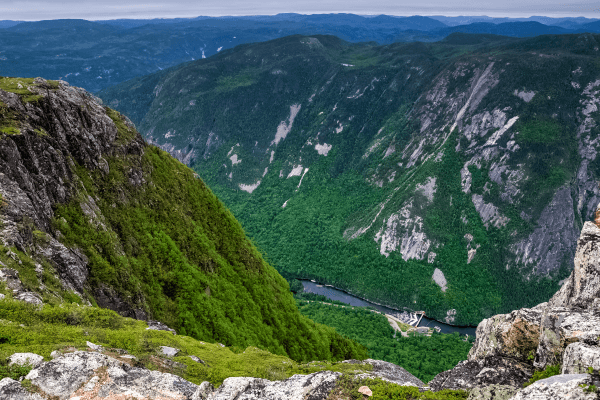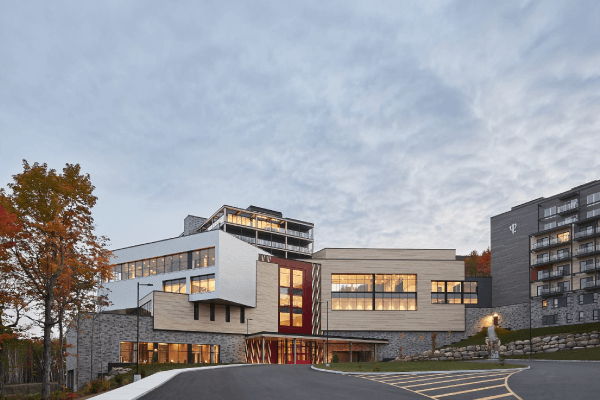To access the other concept sheets in the Tourism unit, consult the See Also section.
Charlevoix is a tourist region of Quebec located on the northern shore of the St. Lawrence River, between the Quebec City, Saguenay-Lac-Saint-Jean and North Shore regions. The region covers an area of 6000 km2 [1]. It features a great diversity of landscapes, with mountains, rivers and access to the St. Lawrence River.
Since 1988, the region has been one of the biosphere reserves recognized by the United Nations Educational, Scientific and Cultural Organization (UNESCO). The Charlevoix Biosphere Reserve has set up several projects over the years to protect biodiversity.
Tourism is an important sector of the region's economy. It receives between 700 000 and 1 000 000 tourists every year[2]. In 2022, as many as 1750 jobs in the region were linked to the tourism industry[3].
The Charlevoix region has been welcoming tourists for almost 200 years. In fact, since the 1800s, people have been visiting the region to take advantage of its landscapes and the St. Lawrence River.
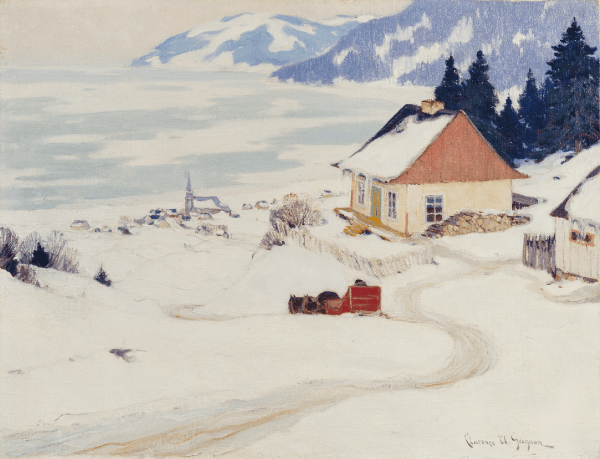
Clarence Gagnon was one of the artists who often travelled to Charlevoix to paint. He produced this painting of a Charlevoix landscape in 1924 or 1925.
Source: La Carriole rouge [Paint], Gagnon, C., 1924-1925, Musée national des beaux-arts du Québec, (URL). Rights reserved* [4]

The Charlevoix region is a popular tourist destination for outdoor enthusiasts. The region has a very distinctive terrain shaped by a meteorite that fell 400 million years ago, as well as periods of glaciation. Deep valleys surrounded by mountains offer exceptional landscapes that delight tourists.
The mountains and proximity to the river offer a diverse range of wildlife and plants, which are showcased by the region's two national parks: Parc national des Hautes-Gorges-de-la-Rivières-Malbaie and Parc national des Grands-Jardins.
Visitors can enjoy a variety of different activities, such as:
-
hiking
-
mountain biking
-
skiing
-
snowshoeing
-
canoeing
-
inflatable rafts
-
kayaking and much more
Summer or winter, Charlevoix is a perfect destination for tourists who want to indulge in nature or adventure tourism.
The region is also an interesting place for tourists wishing to indulge in cultural tourism, including the municipality of Baie-Saint-Paul and the Musée maritime de Charlevoix.
The municipality of Baie-Saint-Paul is known for its vibrant culture and magnificent scenery. Surrounded by mountains and the St. Lawrence River, the town is home to many artisan boutiques and art galleries. It has the most art galleries per capita in Canada. Enchanting architecture adds to the city's charm.
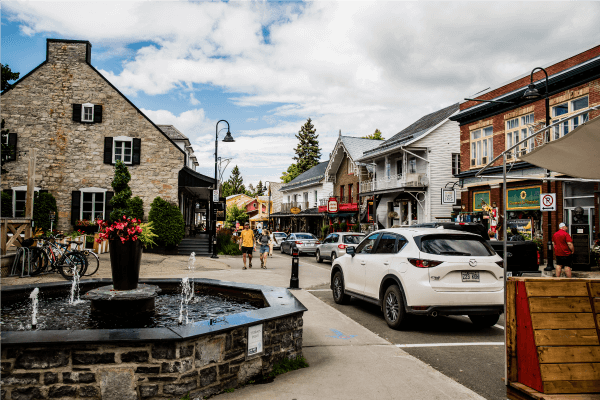
Source: Vincent JIANG, Shutterstock.com
The Saguenay-St. Lawrence Marine Park is a 1245 km2 marine protected area and home to over 2200 species[5]. It's one of the best places in the world for whale watching. Cruises and excursions are available, as well as sea kayaking and even scuba diving.
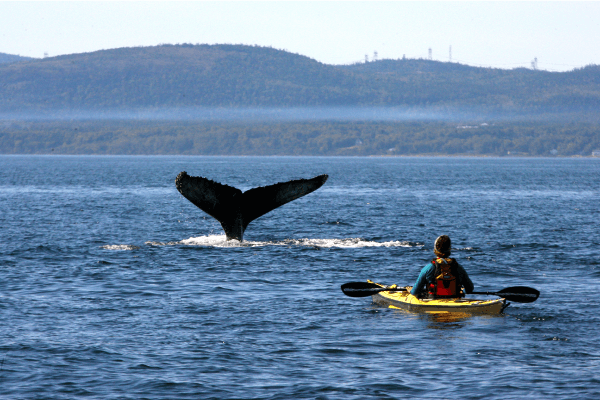
Source: Eric Valenne geostory, Shutterstock.com
The Hautes-Gorges-de-la-Rivière-Malbaie national park is characterized by deep valleys and high mountains, making it the perfect place for a wide range of activities. During the summer, tourists can enjoy hiking, canoeing, kayaking and mountain biking. Winter enthusiasts can enjoy snowshoeing, nordic skiing and even ice climbing.
The Musée maritime de Charlevoix tells the story of schooners (a type of boat) on the St. Lawrence River. It attracts many tourists with 4 ships to visit, a shipyard, various exhibits and its 4-km interactive mountain trail.
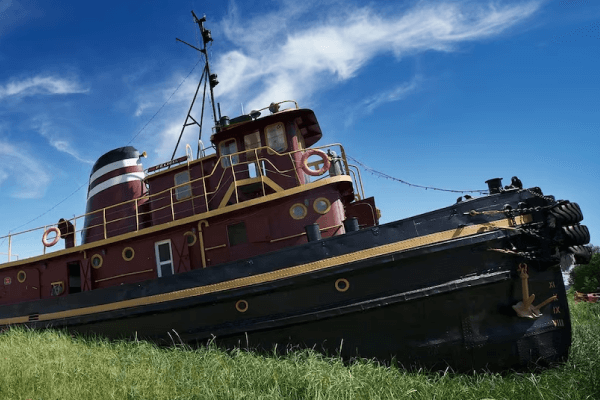
Source: Le remorqueur Felicia, un des bateaux à visiter au Musée maritime de Charlevoix [Photo], Musée maritime de Charlevoix, (n.d.), Radio-Canada Ohdio, (URL). Rights reserved* [6]
The Charlevoix tourist region has been designed to accommodate the many tourists who visit each year.
The region has developed a number of infrastructures to meet the accommodation, transportation and food needs of tourists. Charlevoix offers a multitude of accommodation options, including:
-
hotels
-
chalets
-
bed and breakfast
-
camping sites
-
youth hostels
Many tourists choose to explore the region by car. Route 138 crosses the entire region, running parallel to the river. However, there are several other means of transportation for visiting the region such as:
-
public transit
-
cycling
-
the Train de Charlevoix
-
tourist buses
-
the ferry to Isle-aux-Coudres
Charlevoix also has a great variety of restaurants, bistros, delicatessens and cafés, featuring produits du terroir (local products).
The region has also been developed to include different tourist routes and facilities and to showcase various attractions.Two national parks allow tourists to enjoy the scenery and recreational activities, while protecting ecosystems.
The Route des Montagnes is a 121-km itinerary that passes through two of Quebec's national parks: Parc national des Grands-Jardins and Parc national des Hautes-Gorges-de-la-Rivière-Malbaie. Tourists can enjoy a variety of activities, including hiking, rabaska canoeing, fishing, biking, bear-watching and more.
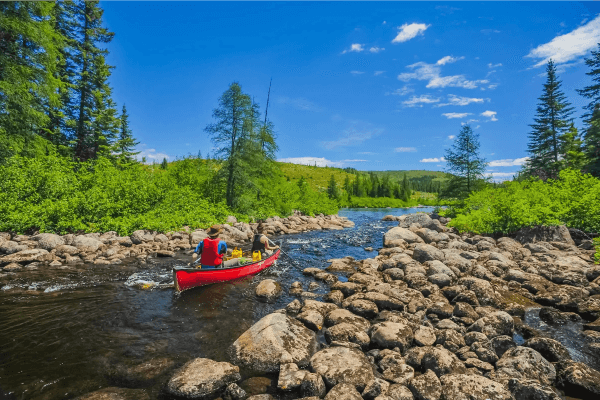
Source: Parc national des Grands-Jardins. [Photograph], Deschênes, S., (n.d.), Tourisme Charlevoix, (URL). Rights reserved*[7]
The Train de Charlevoix offers a 125-km tourist route in a part of the region which would otherwise be inaccessible. It runs from Quebec City to La Malbaie and along the river, offering spectacular scenery.
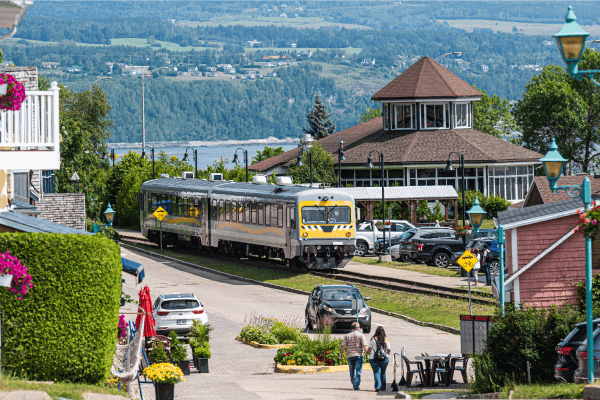
Source: Vincent JIANG, Shutterstock.com
The Charlevoix region is renowned for its excellent local products, such as cheeses. To showcase these products, the Route des saveurs was created in 1996. It is the first of its kind in Quebec. It allows you to visit restaurateurs, producers, livestock farmers, and more.
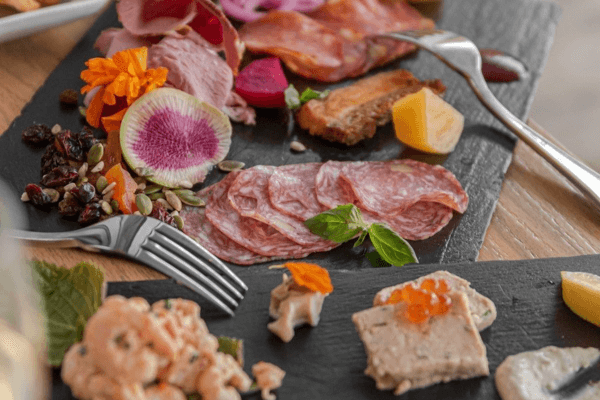
Source: Les producteurs locaux [Photograph], EM photographie culinaire, (s.d.), Tourisme Charlevoix, (URL). Rights Reserved*[8]
The Route du Fleuve crosses the entire region running along the St. Lawrence River and offering spectacular scenery. The 78-km journey can be done by car, motorcycle or even bicycle. It allows you to visit Baie-Saint-Paul, the Musée maritime de Charlevoix and the mills of L'Isle-aux-Coudres.
Le Massif de Charlevoix provides four-season recreation and tourism.
The mountain has the highest vertical drop east of the Rockies, making it the perfect place to indulge in winter sports, such as downhill skiing, snowboarding or tobogganing. Tourists can also go snowshoeing or cross-country skiing. In the summer, tourists can enjoy hiking or mountain biking.
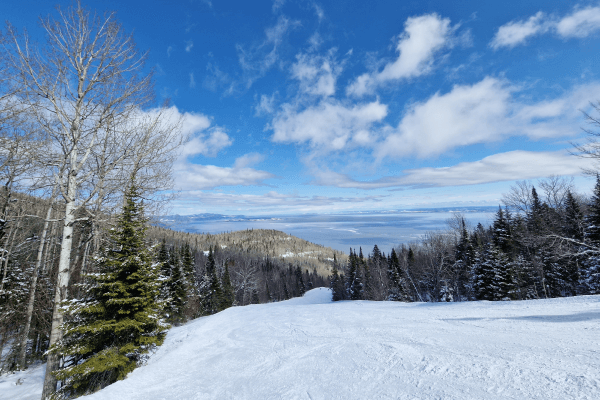
Source: TravellingRWorld, Shutterstock.com
On December 3, 2021, the first Club Med in North America opened its doors at the foot of Le Massif de Charlevoix. It offers an all-inclusive experience and features 302 rooms.
Nature and landscapes are very important attractions to the Charlevoix region. The presence of tourists and the development of infrastructures to accommodate them threaten these attractions. This threat can take many forms.
|
Deforestation |
Removing trees has several consequences for the environment such as the higher risk of erosion by wind or water. As a result, the coasts (banks) become more fragile. |
|---|---|
|
Degradation of water quality |
The development of tourist infrastructures can cause pollution. Water sources are therefore at risk of contamination. |
|
Disruption or destruction of ecosystems |
Tourist infrastructures built in natural areas cause disturbances in the ecosystem of that area. These disturbances can be quite severe and lead to the destruction of the ecosystem. |
|
Increased number of boats on the St. Lawrence River |
Boating expeditions for tourists have an impact on marine life. Marine mammals such as belugas and humpback whales may find it more difficult to move around and find food if there are too many boats nearby. |
|
Loss of natural landscapes |
The addition of new infrastructure, such as roads and tourist accommodation, changes the landscape. These infrastructures, depending on their shape and where they are built, can destroy the natural landscape in which they are located. |
Several measures can be put in place to reduce or eliminate these threats. These include:
-
Reducing deforestation and protecting deforested land
-
Drawing up plans before any work is carried out to enable proper planning by the authorities and reduce the risks of soil contamination, habitat destruction or loss of natural landscapes
-
The creation of lookouts to allow observation of marine wildlife along the shoreline
-
The introduction of regulations governing the observation of marine wildlife
An ecosystem represents all the relationships between a physical environment and the living beings within it.
Located in mountainous terrain, Le Massif de Charlevoix and Club Med Québec Charlevoix have experienced several difficulties with the drainage of their sites, causing erosion.
Work has been carried out year after year to understand and reduce the problems caused by the passage of water, and thus prevent erosion of the mountainsides and the risk of landslides. Culverts found to be too small or in poor condition have been replaced, retention basins have been built, vegetation has been brought back on some sites while drainage around ski trails has been improved.
The housing shortage
As elsewhere in Quebec, Charlevoix is also facing a housing crisis, and tourism is exacerbating this problem.
Affordable housing is already scarce in the region, but it's becoming rarer still due to the growing presence of short-term rental units (Airbnb-type). In concrete terms, this means that there are 181 units in Baie-Saint-Paul, 323 units in Petite-Rivière-Saint-François and 130 units in La Malbaie that could accommodate families or out-of-town workers, but are reserved exclusively for tourists[9].
What's more, the majority of new constructions are tourist residences. In Petite-Rivière-Saint-François, 80% of construction permits for 2022 are tourist residences[10]. In the municipality of Les Éboulements, permits for tourist residences more than doubled in 2020-2021.
The labour shortage
The scarcity of affordable housing also worsens the labour shortage, which is particularly acute during the tourist season. To make up for the lack of workers in the region, companies often hire staff from outside. However, the difficulty of housing these workers seriously hampers the development of companies in the region.
A short-term solution has been put in place through the awareness campaign Être accueillant c'est payant. This project encourages Charlevoix residents to host a worker in exchange for additional income, in order to support local businesses.
Cohabitation between residents and tourists
The cohabitation between Charlevoix residents and tourists is sometimes difficult. Each year, the region receives one million tourists for 30 000 inhabitants[11]. Residents have to deal with traffic jams during the tourist season, illegal camping and litter. These issues were very problematic during the pandemic years of Covid-19. In addition, many residents have to live with very noisy and disruptive tourists.This is the case for residents of Petite-Rivière-Saint-François. The municipality has had to hire security officers to enforce municipal bylaws during busy periods.
The solutions
In its 2023-2027 Strategic Plan, Tourisme Charlevoix aims to develop sustainable tourism. The goal is to establish a form of tourism that responds to the needs of tourists while also meeting environmental needs and the needs of the local population.
That's why, for the first time, the organization is consulting the population of the Charlevoix region to better understand their needs and issues. Among other things, Tourisme Charlevoix would like to make certain tourist infrastructures, which are not used during the off-season, available to residents.
The organization is also looking to promote local businesses and ensure that future tourism projects have a positive impact on the local economy.
To access the rest of the unit, please consult the following concept sheets.
-
Ville de Baie-Saint-Paul. (s.d.). Accès. https://www.baiesaintpaul.com/ville/portrait-de-la-ville/acces
-
Dave Kidd. (2023, 10 avril). Tourisme Charlevoix vise un modèle durable. Le Charlevoisien. https://www.lecharlevoisien.com/2023/04/10/tourisme-charlevoix-vise-un-modele-durable/
-
Gouvernement du Québec. (2023). Portrait de l'industrie touristique. https://www.quebec.ca/tourisme-et-loisirs/services-industrie-touristique/etudes-statistiques/portrait-industrie-touristique#c98274
-
Gagnon, C. (1924-1925). La Carriole rouge [Peinture]. Musée national des beaux-arts du Québec. (URL).*
-
Parc marin du Saguenay-Saint-Laurent. (2023). Bienvenue au Parc marin du Saguenay-Saint-Laurent. https://parcmarin.qc.ca/
-
Musée maritime de Charlevoix. (s.d.). Le remorqueur Felicia, un des bateaux à visiter au Musée maritime de Charlevoix [Photographie]. Radio-Canada Ohdio, (URL).*
-
Deschênes, S. (s.d.). Parc national des Grands-Jardins [Photographie]. Tourisme Charlevoix. (URL).*
-
EM photographie culinaire. (s.d.). Les producteurs locaux [Photographie]. Tourisme Charlevoix. (URL).*
-
Tremblay, L. (2023, 13 juin). Les résidents sont invités à accueillir des travailleurs pour l’été. Le Charlevoisien. https://www.lecharlevoisien.com/2023/06/13/les-residents-sont-invites-a-accueillir-des-travailleurs-pour-lete/
-
Brunet, C. (2022, 2 août). Petite-Rivière-Saint-François envahie par les résidences touristiques. Radio-Canada. https://ici.radio-canada.ca/nouvelle/1902527/petite-riviere-saint-francois-envahi-residences-touristiques
-
Béland, G. (2022, 29 décembre). Charlevoix à la croisée des chemins. La Presse. https://www.lapresse.ca/actualites/2022-12-29/tourisme/charlevoix-a-la-croisee-des-chemins.php
*Extrait employé par Alloprof conformément à la Loi sur le droit d'auteur dans le cadre d'une utilisation équitable aux fins d’éducation [https://laws-lois.justice.gc.ca/fra/lois/c-42/page-9.html]
